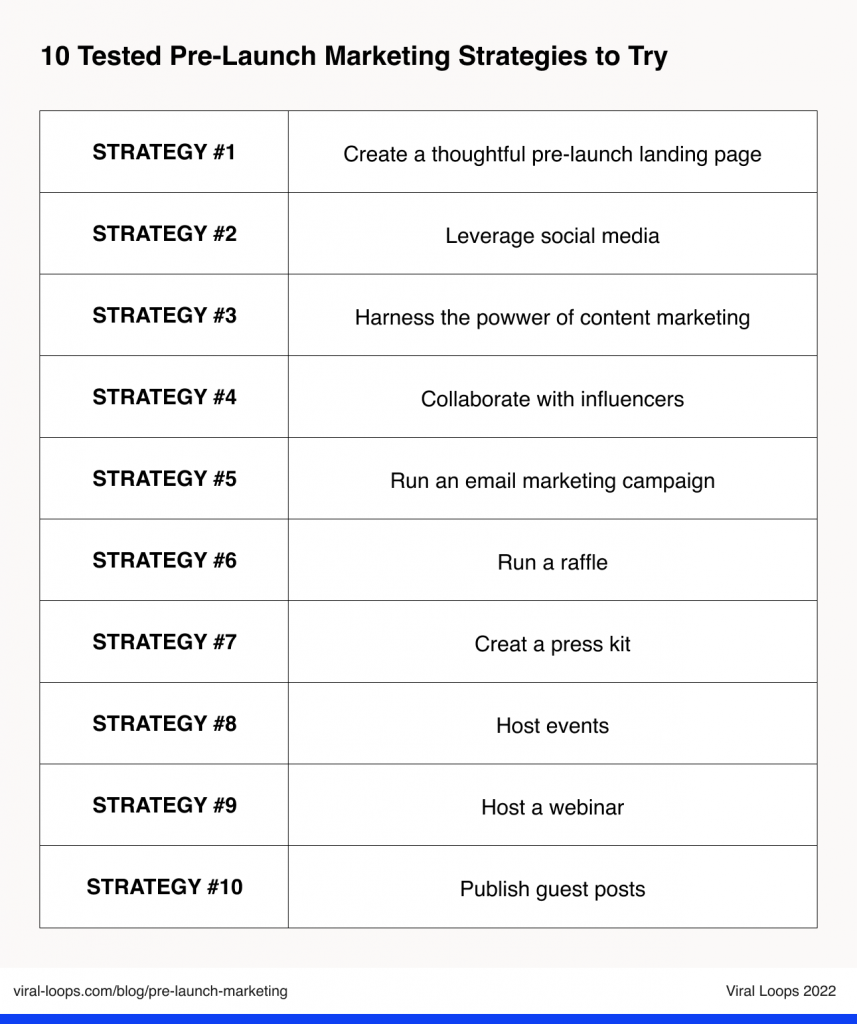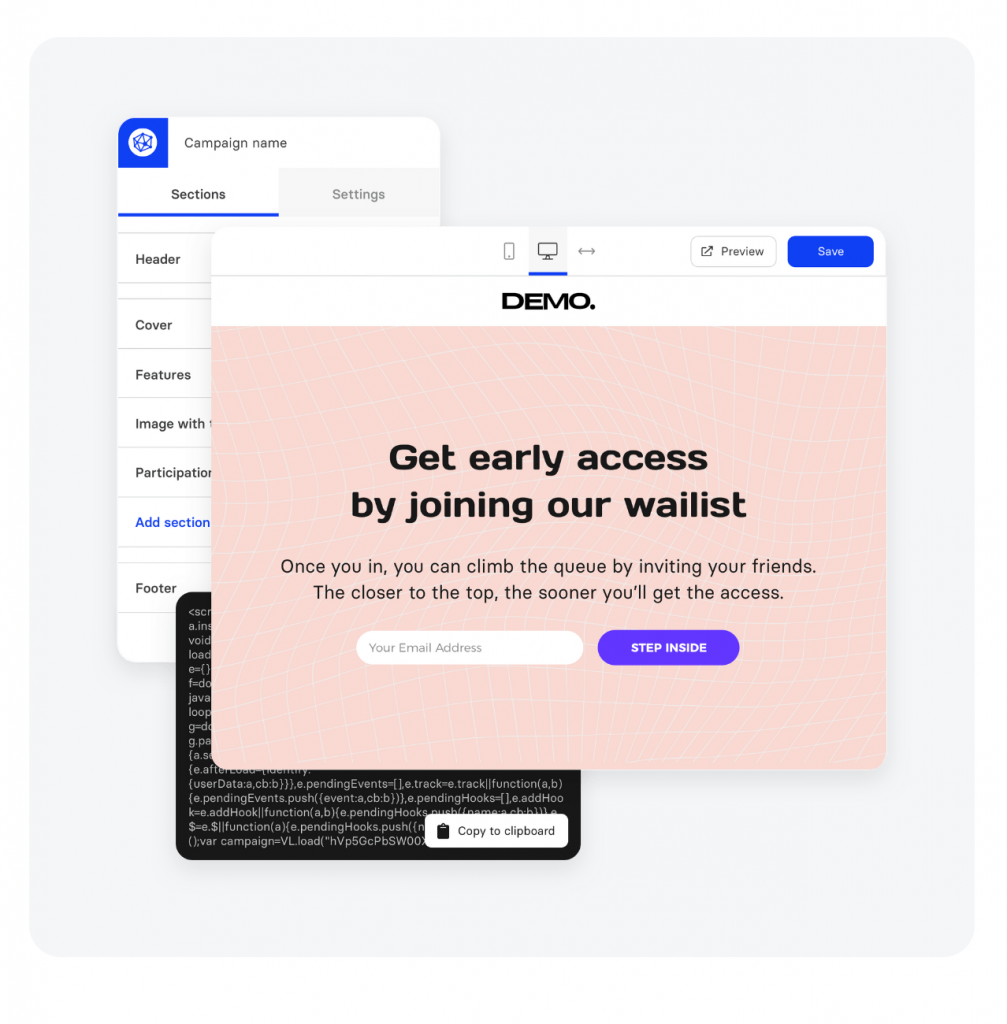It’s thrilling to release a new product and see its popularity soar.
However, a significant amount of effort goes into developing a pre-launch marketing plan that ensures the launch’s success.
Building support for the product, attracting attention in the market, eliciting favorable comments, and laying the groundwork for a successful launch are the objectives of a pre-launch marketing plan.
So, we have created this guide to ensure that your pre-launch marketing plan is beyond solid and reaps all the benefits for you.
We have included the following in our post:
- What is pre-launch marketing?
- What are the benefits of pre-launch marketing?
- 10 tested pre-launch marketing strategies to try
- 3 tips for successful pre-launch campaigns
Let’s jump in!
Table of Contents
What Are the Benefits of Pre-Launch Marketing?
10 Tested Pre-Launch Marketing Strategies to Try
3 Tips for Successful Pre-Launch Campaigns
What is Pre-Launch Marketing?
Pre-launch marketing is the process that happens before the formal introduction of your product or service to increase brand recognition and enthusiasm.
It’s also an excellent opportunity to experiment with new marketing channels and methods to see what works.
When done right, pre-launch marketing can open many great doors for you.
Let’s check the advantages together.
What Are the Benefits of Pre-Launch Marketing?
Pre-launch marketing allows you to raise awareness of your product, develop excitement and buzz about the upcoming launch, and generate essential leads.
In addition, a pre-launch marketing campaign is an excellent way to evaluate the effectiveness of various marketing platforms.
You can also solicit feedback on your product to determine how well it’s received and fine-tune your development and marketing.
When done correctly, pre-launch marketing activities allow you to hit the ground running with the following in place:
- Establishing a well-known and search-engine-optimized website that helps you create a strong social media presence and following
- An engaged audience that’s eager to purchase and willing to recommend additional clients to you
- Connections with ambassadors and influencers keen to promote your new product
- Some favorable news coverage and the associated authority
- A solid marketing plan that includes who your target audience is, the best way to reach it, and a clear strategy that provides for specified objectives and how to accomplish them
- The momentum generated by the audience’s expectations, excitement, and positive chatter
As you can see, a tremendous pre-launch marketing strategy is beneficial and will set you up for success.
10 Tested Pre-Launch Marketing Strategies to Try
Pre-launch stages can last from a few weeks to several months, but by the conclusion of the pre-launch, you should have:
- A receptive audience eager to purchase from you
- Followers on social media and email subscribers
- A thorough grasp of the sorts of marketing that are effective for your target demographic and organization
The following strategies will help you achieve precisely that!

Strategy #1: Create a thoughtful pre-launch landing page
Before launching any marketing activities, ensure that you can capture any leads that come your way.
A landing page is a solo page—as opposed to your website, which contains a menu of numerous pages—and they’re used by marketers to entice visitors to take a single action prior to the launch of a product.
Moreover, visitors can be asked to sign up for a free trial, purchase a product, or book a sales call.
Here are some pointers for developing a landing page for your pre-launch campaign:
- Use exit pop-ups:
Exit pop-ups are pop-up boxes that appear when a user attempts to leave a page.
They’re also a last-ditch effort to get a visitor to stay on your website.
In addition, you can provide a discount or voucher code to keep the user interested, or you can simply request that they sign up for your mailing list so they can be the first to learn about new products.
- Have a clear call-to-action (CTA):
In the marketing world, the term “CTA” is frequently used, but what does it represent, and why is it crucial for your pre-launch website?
A call-to-action signal on your landing page instructs potential consumers on their next steps.
Typically, it’s a directive term or phrase with a touch of politeness, guiding visitors beyond mere website browsing to decision-making.
To put it another way, CTAs encourage potential customers to take action, which helps you obtain the outcomes you desire from your pre-launch campaign.
- Clearly describe the product:
It’s critical that you describe your product in detail.
Bear in mind that explaining the product is different and helps people understand the product.
The description aims to increase people’s confidence in what they’re getting into.
So don’t go for something long; just keep it as concise as possible.
The best part is that we can help you build your own landing page perfectly!
With our pre-launch templates, you’ll get to discover different attributes and looks and pick what suits you most.
You can create a straightforward pre-launch landing page with us like the one you see in the image below.

This isn’t a chance to be missed, so make sure you take a look around.
Strategy #2: Leverage social media
Your pre-launch social media marketing approach is crucial.
Here, you can truly develop suspense and excite your audience about your new offerings.
Here are some simple pre-launch social media marketing ideas:
- Not-completely-revealing, suspense-building video teasers
- Product development updates that explain a little bit about the product and why it’s so exceptional
- Building a countdown or timer to create an ambiance of excitement
- Live AMAs (ask me anything) with colleagues or the CEO
- Polls and surveys on the potential alternatives you might provide
- Contests, competitions, and prizes on social media posts
- Social sharing and posting ratings from influencers and creators
- Maintain a close eye on your mentions and consumer questions on social media posts
- Creating a distinct hashtag for others to use
The more dynamic, entertaining, and unique or personal your social media is, the better.
Moreover, you need social media to interact with and develop a connection with your target market.
Remember that social media and influencer marketing is also a terrific tactic for building reputation and trust.
Strategy #3: Harness the power of content marketing
The content you produce and publish should have a context, a purpose, and be related to your branding in some way.
Hence, it’s better for your content marketing to entail offering free or gated, quality information to increase interest in your brand or items.
These are examples of content marketing:
- Infographics
- Video tutorials
- Live videos
- Case studies
Using content marketing in a pre-launch plan might help you generate a need among your target audience.
Content marketing, which involves educating your audience and gaining its trust, is ideal for this phase of your marketing launch.
You don’t yet have a product or service to offer, but you’re aware of the problem your product or service can solve and what sets it apart from the competition.
In addition, you must begin communicating this information to your audience.
This is where content marketing becomes relevant.
For example, consider that you’re launching a company that offers eco-friendly apparel.
You may publish informative articles regarding the environmental effect of rapid fashion.
Alternatively, you can produce videos on the most effective methods for recycling, reusing, and donating clothing.
This will attract individuals interested in eco-friendly fashion.
They can begin following you due to your content and then become customers when you’re ready to launch.
So, ensure you have a specific audience in mind for your content marketing efforts.
The greater your understanding of that audience, the greater the value proposition you can deliver.
Strategy #4: Collaborate with influencers
Cooperation with thought leaders and influencers in your niche can add enormous value to your pre-launch marketing efforts.
That’s why it’s an excellent pre-launch marketing plan to consistently reach out to magazines, journalists, and bloggers in your area in an attempt to:
- Set up a meeting with your CEO or product designer
- Arrange for a product evaluation
- Submit a guest article or a podcast
- Suggest comparing your goods to the alternatives
Remember to avoid being aggressive and adhere to PR best practices.
If the recipient doesn’t reply, don’t bombard them with follow-up communications.
In addition, reaching out beforehand with an email creates an opportunity to write again after the launch.
If any experts doubted your capacity to bring the product to market, the launch day or launch date notification could stimulate their interest.
Strategy #5: Run an email marketing campaign
The majority of customers not only expect to get emails from businesses but also welcome them.
While shopping, individuals frequently browse their email inboxes for discount coupons or deals.
So add a sign-up form to your website as a first step, and make it simple to complete.
Using email automation, you can periodically send a series of greeting emails.
Moreover, your welcome series must introduce subscribers to your business, ensure lead generation, optimize pricing, focus on brand awareness, and promote website visits.
Growing your email list should be your main goal.
Also, you may use lead magnets and landing pages to get visitors to subscribe to your emails.
As your email list grows, you can send out product releases and specials to entice them to buy.
Strategy #6: Run a raffle
Running a raffle with entries for recommendations and referrals is a terrific approach to gathering leads, increasing your email list, and creating hype for your coming-soon new product launch.
To encourage individuals to ‘play’ to win, you can gamify the process or create tiers with increasingly valuable rewards.
The more referrals and new customers people generate, the more entries they receive and the greater the prize’s worth.
In addition, prizes can be merchandise, discount vouchers, branded swag, giveaways, or anything else you can think of.
This kind of raffle is extremely beneficial for acquiring leads and contact details.
You can also use them to re-target referrals who didn’t win anything at all in your raffle by providing them with a customized discount or promo code in the post-launch phase.
Strategy #7: Create a press kit
A public relations kit (also known as a press kit or a media kit) is a bundle of promotional materials journalists will need to write about you and your new product.
This process provides journalists with simple access to pre-order information, and high-quality photographs boost your chances to build up maximum coverage.
Here’s what you should include in your public relations kit:
- Years in business, key milestones and successes, goal statement, and so forth
- Senior management bios: these introduce the CEO and top managers (or the whole team if it is small) and describe their present responsibilities in the firm and areas of expertise. This will assist with maintaining consistency in citations and will demonstrate that you’re available for interviews
- Product factsheet: key characteristics and an explanation of how it differs from competitors
- Product photos: high-resolution shots of your product in its best light
- Brand logos: building brand recognition is essential for pre-launch product promotion, therefore make your logo as visible to consumers as you can.
Strategy #8: Host events
Whether you’re introducing a new place or a new product to the market, consumers will welcome the chance to see and touch it.
Hosting events can be used to attract passersby as well as a social media audience following the event. The latter allows you to engage with individuals who wanted to attend in person but couldn’t.
Furthermore, creating a fantastic event, complete with gifts and entertainment, won’t only help you generate awareness but will also establish favorable connections between your company and product and their audience.
In what way does this relate to pre-launch marketing?
In this situation, for your event to get enough attention, it should be marketed in advance.
To make the investment worthwhile, get your fans to exchange information and invite their friends, collaborate with influencers, apply that knowledge to remind people about the approaching event, and encourage the media to promote it.
Strategy #9: Host a webinar
Before you introduce your product to the public, make sure you’re fully equipped with audience insights such as pain areas, frequently asked questions, and the phrases people use to convey their concerns and difficulties.
Your pre-launch plan should address the following questions:
- What problems are you addressing with this campaign/product?
- What distinguishes your product from others already on the market?
- Who would benefit from this product/campaign?
- How can you acquire precise responses to these questions?
Moreover, webinars are one of the most successful and efficient methods of gathering consumer insights.
You can discover whether your audience understands a certain topic or subject.
In addition, through a webinar and the responses it triggers, you can establish if any issues need to be addressed and also the language your audience uses to communicate its pain points and concerns.
Strategy #10: Publish guest posts
Organic traffic is often minimal during the pre-launch phase since most people are unaware of your product.
Guest blogging might be an excellent approach to introduce your company to a whole new audience and generate organic traffic.
You can write guest pieces for popular websites and link back to your own.
Remember that it’s usually preferable to begin guest posting as soon as feasible.
However, most individuals and organizations begin guest blogging after it’s too late or after the product has already gone live.
Furthermore, you must realize that you’re doing guest blogging to get initial traffic.
Therefore, sending traffic to an existing famous website won’t benefit you much.
In such a situation, you should concentrate on your own website’s content, SEO, and rating.
3 Tips for Successful Pre-Launch Campaigns.
Now that you have explored numerous ways to set your pre-launch marketing plan, these tips are the final cherry on top to construct your campaign in the best shape.
- Know your target customers:
This essential component of any marketing strategy gives practical information on the target audience.
It entails investigating demographics, individual preferences, hobbies, and other variables.
Also, companies that understand their target consumers may create customized content to advertise their products successfully.
- Find your message:
People are moved by emotions, not facts.
Therefore, your message should appeal to your potential customers’ hearts, not their heads.
So ensure that you position yourself in a manner that resonates with your clients and distinguishes you from the competition.
- Set goals and metrics:
Setting well-defined and ambitious objectives that are achievable within a certain period allows you and your team to construct a game plan that will serve as a means to coordinate your efforts and keep you on track.
Once the objectives have been established, it’s necessary to identify and collect the metrics that will support the goals and provide insight into how well they were accomplished.
Now Over to You
A pre-launch marketing plan will allow you to get your product off to a strong start, yet many startups neglect to implement one.
An adequately planned pre-launch marketing strategy is one of the most important aspects of a successful product launch.
This is where you set the groundwork for your product’s successful development and it’s essential to that success.
Furthermore, if you need assistance boosting your pre-launch campaigns using the power of referral marketing, schedule a free demo, and we’ll walk you through the process from start to finish.
Thank you for your time!
